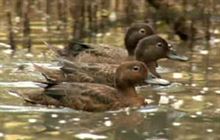Brown teal/pāteke
Introduction
The Brown teal/pāteke is a small dabbling duck endemic to New Zealand historically distributed throughout the lowland freshwater wetlands.New Zealand status: Endemic
Conservation status: Nationally Increasing
Found in: Northland, Great Barrier Island, Coromandel, Abel Tasman and Milford
Threats: Predation, habitat disturbance, hunting, vehicles, lack of food
Species information: Brown teal on NZ Birds Online
Image gallery
-
Getting brown teal ready for transport Image: Sabine Bernert ©
![Putting brown teal into box. Putting brown teal into box.]()
-
Brown teal adult and ducklings Image: Sabine Bernert ©
![Brown teal ducklings. Brown teal ducklings.]()
-
Applying glue to a leg band on brown teal Image: Sabine Bernert ©
![Two people banding a brown teal. Two people banding a brown teal.]()
Pāteke/brown teal conservation
Since 1988, pāteke/brown teal have suffered an ongoing decline in numbers and range. In 2022, there are estimated to be between 2,000 and 2,500 pāteke/brown teal living in a wild state in New Zealand, making the species New Zealand’s rarest waterfowl on the mainland.
Pāteke were once widespread throughout New Zealand. They are now rare and restricted to coastal areas of eastern Northland, Great Barrier Island and several other locations around New Zealand where new populations have been established using captive reared birds.
Pāteke were listed as "Nationally Endangered" until 2008, when the conservation status was changed to "At risk-increasing". This status change was driven by considerable effort to halt the extinction of pāteke. So while numbers are slowly increasing, and the recovery programme has been effective, pāteke are still vulnerable. They could again become at risk of extinction if threats are not managed.
These threats include:
- predation (mainly from introduced mammals)
- habitat loss (through wetland drainage, forest clearance, estuary reclamation and climate change)
- hunting
- being run over by vehicles on roads
- dry spring and summer conditions which reduce food abundance
- competition and hybridisation with mallards when populations are low.
In combination these factors have a significant negative impact on pateke populations.
Our work
There are four main approaches to recover pāteke nationally:
- predator control
- habitat restoration
- captive breeding and release of birds to form new populations at well managed sites
- raising public awareness to the threats and management opportunities that exist in assisting the species to recover.
The long term recovery goal for pāteke is to establish the species as an icon of instream, wetland health and conservation-friendly farming practices. We are achieving this goal by our 'breed for release' programme which includes our captive breeders and community groups.
View this map to see current work and reintroduction sites.
Successes
- Wide scale community driven predator initiatives both on the eastern Northland and Coromandel peninsula have seen pateke range and numbers increase in recent years.
- Our captive coordinator, Kevin Evans, was awarded a 2022 new year’s honours for services to wildlife conservation and the community.
- The single biggest success has been the change in pāteke National threat status (from endangered to at risk- increasing) due to the focused efforts of largely volunteer stakeholders over the last two decades.
Supporters
- Ngātiwai as all remaining pāteke whakapapa go back to the rohe (territory) of this iwi.
- Captive breeders who produce birds for release.
- The Isaac Conservation and Wildlife Trust who provide facilities for pre-release conditioning and processing (banding, transmitter attachment, disease screening, etc).
- Community groups who do intensive predator control at site with good habitat.
- Air New Zealand partnership with DOC and transporting pāteke safely across the country.
You can help pāteke
Report any sightings of pāteke at new locations.
Get involved in pāteke recovery:
- visit the Brown teal website and Facebook page
- get advice in the Pāteke survival guide.
Contacts
For more information:
Jenny Hayward, Pāteke Recovery Group Leader
- Email: jhayward@doc.govt.nz
- Phone: +64 27 378 3566
For captive programme queries:
Kevin Evans, Pāteke Recovery Group Captive Coordinator
- Email: kevin@brownteal.com
- Phone: +64 27 439 2561
Emergency hotline
Call 0800 DOC HOT (0800 362 468) immediately if you see anyone catching, harming or killing native wildlife.
On your property
- Trap predators on your property.
- Be a responsible cat owner.
In your community
- Find and volunteer with your local community group
- Trap predators in your community
- Get kids or schools involved
See Predator Free 2050 Trust - get involved for information.
Visiting parks, beaches, rivers, and lakes
- Leave nesting birds alone.
- Use available access ways to get to the beach.
- Avoid leaving old fishing lines in the water.
- Follow the water care code and local navigation bylaws.
- Do not drive on riverbeds, or keep to formed tracks if you have to.
- Check for pests if visiting pest-free islands.
With your dog
- Only take dogs to areas that allow them, and keep them under control.
- If you come across wildlife put your dog on a lead and lead it away.
- Warn other dog owners at the location.
- Notify DOC if you see wildlife being harassed by people or dogs.
- Get your dog trained in avian awareness.
- Learn about the Lead the Way programme which encourages dog owners to become wildlife wise and know how to act to protect coastal wildlife.
Specific ways to keep wildlife safe while with your dog on beaches.




